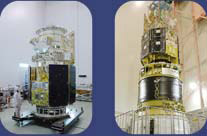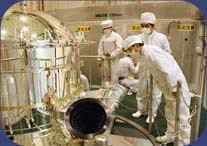|
 |
 |
 |
 |
 |
 |

So far, nobody has really been able to observe extrasolar planets. Although Akari cannot see the planets themselves, it can observe dust disks, which give birth to planetary systems, as they are very bright in the infrared. IRAS observed a very early stage of a planetary system 20 years ago, but it was not sensitive enough to pick up any details. We cannot wait to be able to study what IRAS did not allow us to see. Infrared rays are also useful in studying the birth of stars. While a star is being born, gas and dust disks with strong infrared radiation are also forming. The infrared radiation from the dust disk darkens as planets form, so we hope that studying this process will allow us to learn about the formation of planetary systems, including our own. Also, because dust disks sometimes remain around old stars, we think that, by studying these stars, we will be able to understand what sort of stars tend to form planetary systems. |
 |

Birth of a galaxy, captured by SST (NGC 4579)
A dust disk is the origin of a planetary system
|
 |
 |


Most infrared rays are absorbed by Earth's atmosphere before they reach the ground, so we cannot observe them from here. Infrared observation has to be done from outside the atmosphere, especially when it comes to distant objects. In addition, infrared observation must be carried out at extremely low temperatures because otherwise the telescope itself emits infrared radiation, which skews its measurements.
Even before the IRAS mission, Japan had been considering launching an infrared telescope of its own into space. The size was not a concern; no matter how small it was going to be, we just wanted to find out what the obstacles to observation would be.
Finally, in the 1990s, Japan was ready to launch the Infrared Telescope in Space (IRTS). We considered using the space shuttle as a carrier, but in the end, in 1995, an experimental satellite called SFU was chosen to launch the 15 cm telescope into orbit.
The IRTS experiment was a success, demonstrating that Japan could master the technical challenges of using liquid helium to cool the telescope, and the design of our first infrared astronomical satellite began in 1996.
Astronomers are always wanting more, so we soon started talking about the possibility of building a much larger telescope. At the time, the M-V rocket was the option of choice for launching a scientific satellite, so our next goal became the production of the biggest telescope that would fit in the M-V's faring. The M-V's diameter is 2.5 m, so we ambitiously aimed to build a one-meter telescope. The M-V can deliver approximately 1800 kg into orbit, so a large satellite like Europe's ISO, which weights 2400 kg, was out of the question. Also, it was estimated that 2200 liters of liquid helium, or about 310 kg, would be needed to cool the telescope.
In due course, we designed the mechanical parts to be as small and as light as possible, which Japan is very good at, to build a large telescope that would fit in a small space. We built a satellite not quite as large as SST, which is 85 cm, but the world's second-largest infrared space telescope, at 68.5 cm (in third place are ISO and IRAS which are both 60 cm). By introducing a cooling unit, we were able to reduce the amount of liquid helium required to only 170 liters (about 24 kg), less than a tenth of the amount carried by ISO. (SST carried 360 liters, or 50.4 kg). The observation period is about a year and a half, about a year shorter than that of ISO and SST. Thanks to the cooling system, however, we will be able to continue some observations even after the liquid helium runs out. In addition, the telescope has world-class sensors, developed in collaboration with NICT, the National Institute of Information and Communications Technology. We have integrated all Japan's technologies, involving many institutions and universities, principally among them Nagoya University and Tokyo University. |
 |


Multifunctional experimental satellite SFU |

Infrared Telescope in Space (IRTS) |

Akari awaits its launch

Murakami, in the foreground, giving the final check prior to the launch of ASTRO-F at the Uchinoura Space Center |
 |

 |
|



